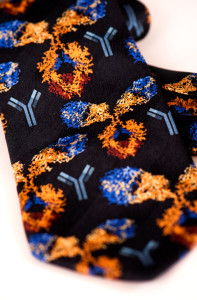
B cells learn early on how to make many kinds of antibodies. What role do microbes in the gut play in teaching them to do so?
It’s long been thought that in people and in mice this reshuffling process—called V(D)J recombination, after the B cells’ antibody-coding V, D and J gene segments—takes place in two places: the bone marrow and the spleen. But new research from a team led by Frederick Alt, PhD, and Duane Wesemann, MD, PhD, suggests that there may be one more place B cells go to undergo recombination: the gut. What’s more, that reshuffling in the gut may be influenced by the microbes that live there.
Now, early B cell programming in the gut isn’t unheard of; it happens in species as diverse as sheep, rabbits and chickens. “The B cell gets its name from the fact that it was discovered in chickens in an organ called the bursa,” says Alt, who directs the Program in Cellular and Molecular Medicine at Boston Children’s Hospital. “That organ is in the chicken’s gut, and is an important training site for the chicken’s B cells.”
In fact, the presence of B cells in the gut is perfectly normal as well. The lamina propia (LP), a layer of loose connective tissue just underneath the gut surface, is chock-full of mature B cells ready to grab pathogens that try to cross into the blood stream.
However, while working on the origins of a kind of B cell lymphoma, Alt and Wesemann noticed immature B cells (B cells that have not yet fully developed) in the LP of young mice. That came as a surprise, as typically only mature, fully-grown B cells would be found in the gut. “They’re not mature, they’re not producing antibody, why were they there?” Alt asks.
When examined, those immature cells showed evidence of active V(D)J recombination, a sign that their antibody repertoire was becoming more diverse—the cells were gaining the capability to react to more potential pathogens. What’s more, as Alt and Wesemann reported in Nature, the repertoire in the LP of these mice differed markedly from that in the bone marrow, suggesting that cells in the two locations were under different influences.
To better understand these influences, Wesemann took young mice that had been raised germ-free and housed some of them with mice from a regular (non-sterile) animal facility, allowing their guts to be colonized by microbes from their cage mates. The researchers then compared the level of antibody gene reshuffling in gut B cells from the colonized mice versus the mice that stayed germ-free.
“The findings bring B cells into the picture of how gut microflora influence immune development, but they raise more questions than they answer.”
The results: Immature B cells from the colonized mice showed evidence of much more gene reshuffling than their germ-free peers, suggesting some kind of interaction between the gut microbes and the young B cells. In addition, the colonized mice had more reshuffling activity in immature B cells in the spleen and bone marrow, reinforcing the notion that gut microbes influence immune cell development throughout the body.
How and why this is happening is still unclear. What signals are the microbes producing? What roles do particular species of bacteria play? No one yet knows the answers to these or other questions, but the age of the mice may be a factor.
“It appears to happen only in a narrow window of time, when young mice are weaning,” says Wesemann, who was a senior postdoctoral fellow in that Alt lab and recently opened his own independent laboratory at Brigham and Women’s Hospital. “It’s a time period when environmental influences could help shape an animal’s antibody repertoire.”
“There also may be a relationship to allergies or food tolerance,” Wesemann adds. Since immature B cells also exist in the LP of humans, the same training process he and Alt found in mice could be taking place in us, he says.
The gut microbiome’s sway over the immune system—its capability to train immune cells and dampen over-reactions—has been a hot topic in recent years. But as Alt explains, much of that work has focused on T cells.
“The findings bring B cells into the picture of how gut microflora influence immune development,” Alt says, “but they raise more questions than they answer.”







